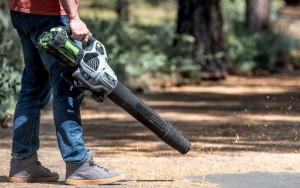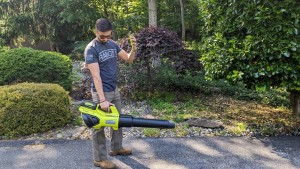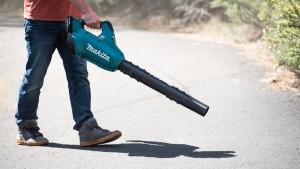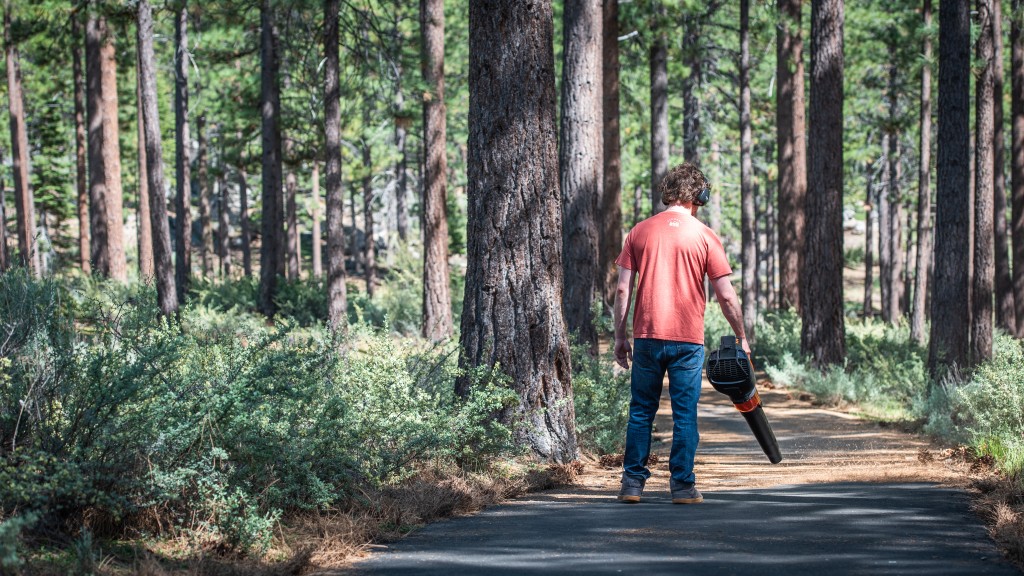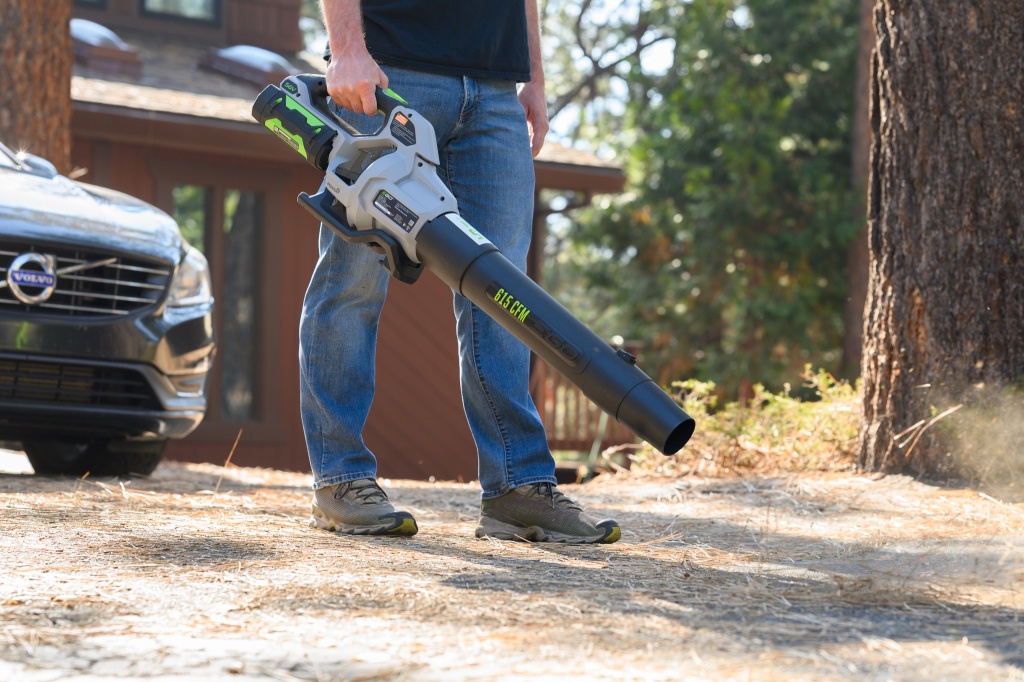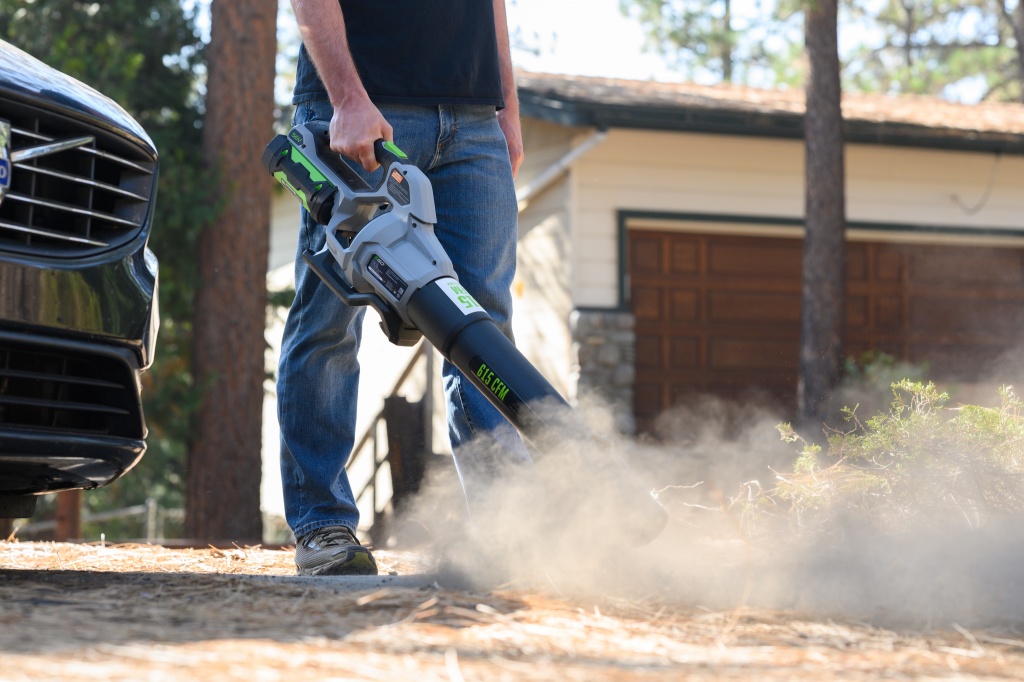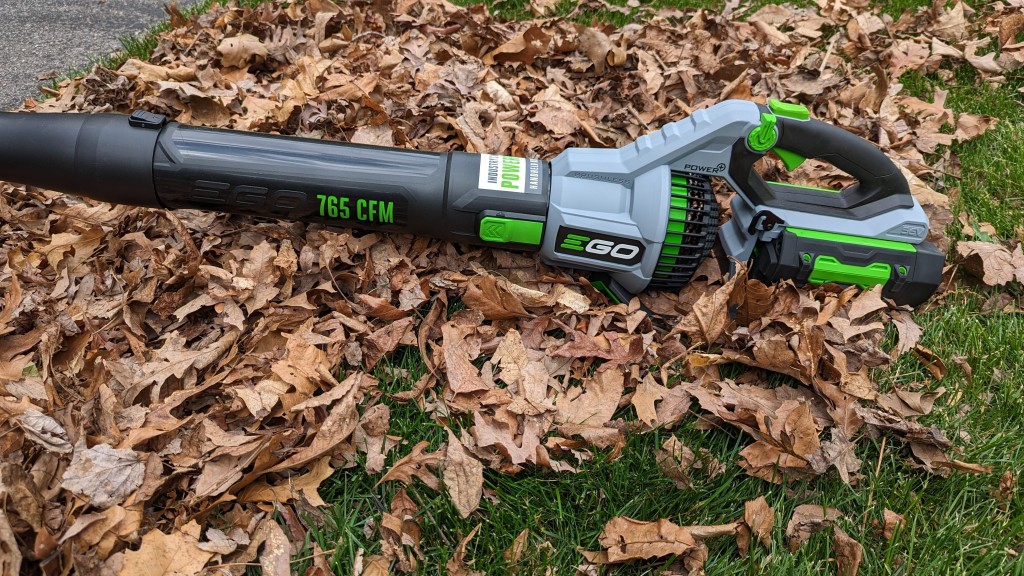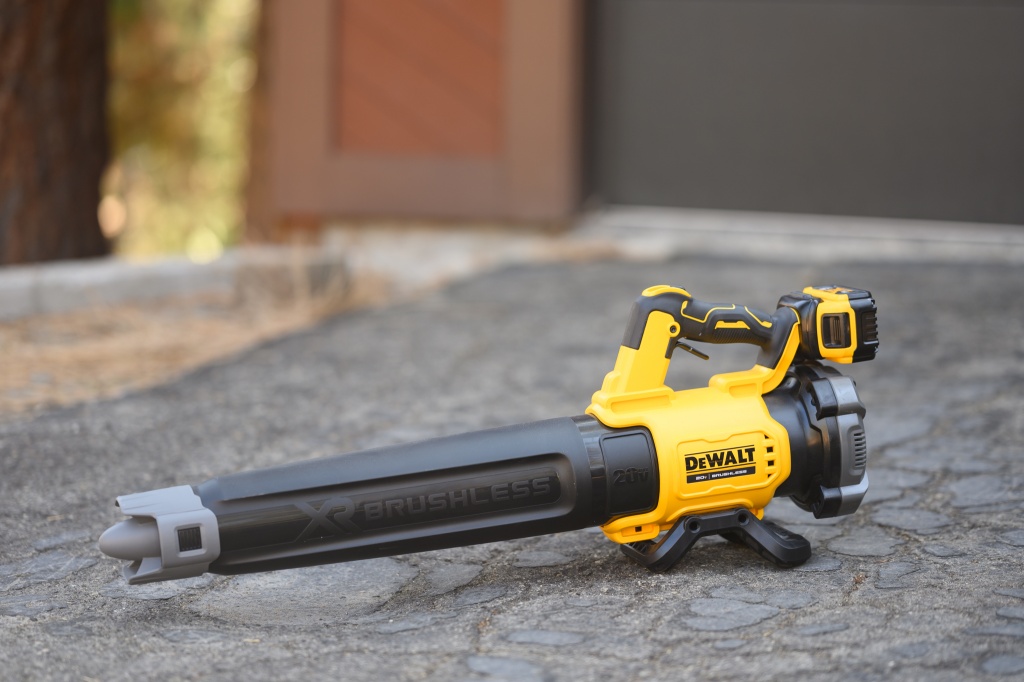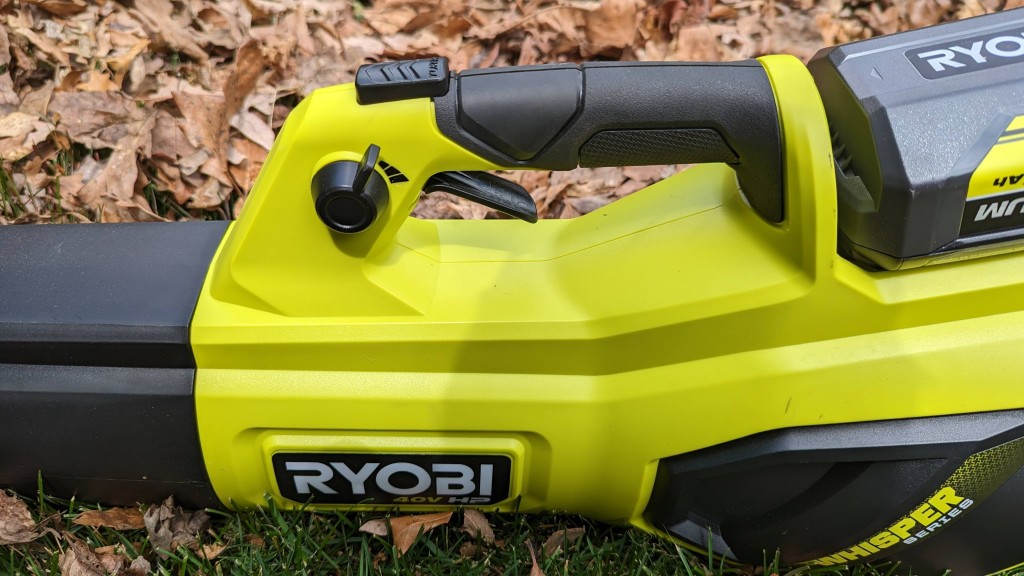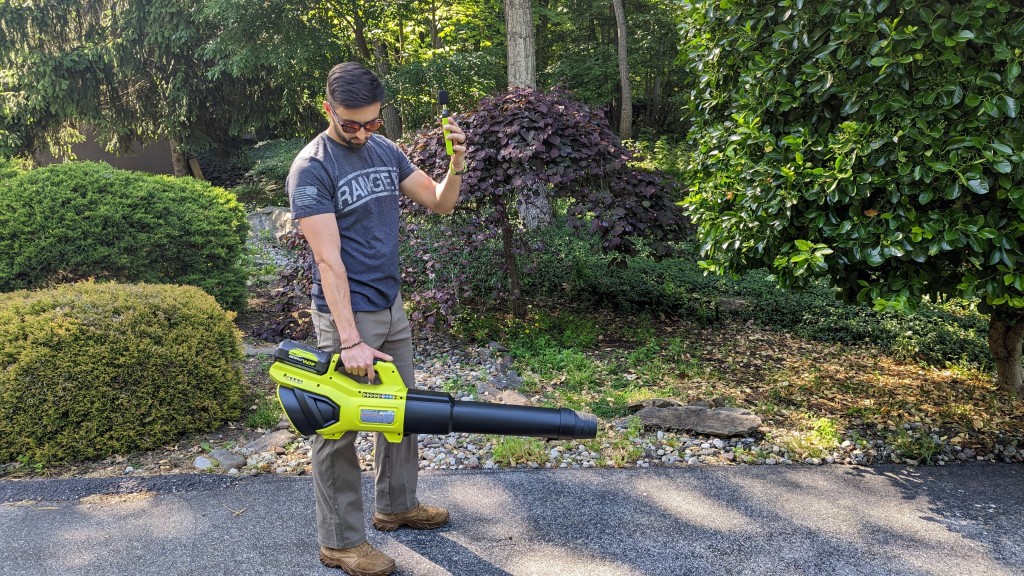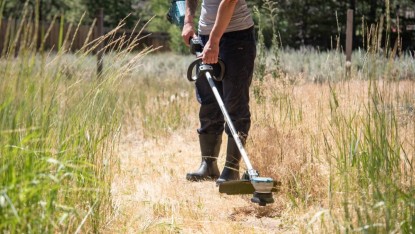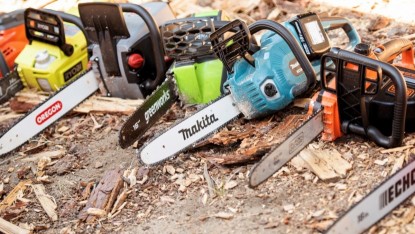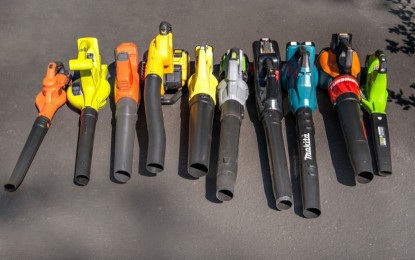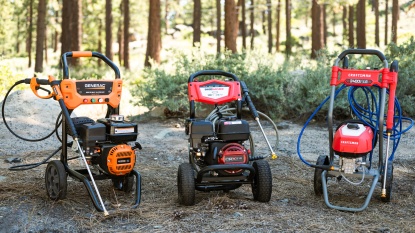Ready to have that picture-perfect lawn? Over the past 4 years, we've tested 15+ of the best leaf blowers, bringing you the top 8 available today. We've cleaned driveways, decks, and patios with these tools, rating and ranking the cleaning power of each. We even bought a specialized anemometer in order to measure air velocity and airflow. We compared the ergonomics and ease of use of each tool, as well as their battery life, noise level, and quality. No matter your yard size or your budget, we've found the perfect leaf blower to help you strive for that debris-free life.
Editor's Note: We updated our leaf blower article on November 13, 2023, to include more details outlining our testing process and to ensure product availability.| Awards | |||||
|---|---|---|---|---|---|
| Price | $220 List $235.94 at Amazon | $329 List $195.00 at Amazon | $329 List $290.76 at Amazon | $389 List Check Price at Amazon | $249 List $239.00 at Amazon |
Overall Score  |
|||||
| Star Rating | |||||
| Pros | Impressive power, cruise control settings, fast battery charging | Powerful, excellent performance, well balanced | Mighty, outstanding battery life and recharge time | Plenty of strength, ergonomic, interchangeable batteries with other handheld cordless Makita tools | Lightweight, includes speed lock setting |
| Cons | Not the longest battery life | Expensive, poor battery life | Not well balanced, heavy | Expensive, requires two batteries | Not very powerful, battery has short runtime, 90-minute recharge time |
| Bottom Line | This model was the highest-scoring blower we tested, and one of the most cost-efficient options | When power is king the Ryobi rules easily; however, it burns through a four amp-hour battery so we recommend buying a larger battery for this blower | With a high power output and excellent run time this heavy model can keep on going | This is a solid blower on its own merits and has interchangeable batteries with handheld Makita power tools | This model will appeal to folks who already own an arsenal of cordless DeWalt tools, but it isn't our favorite |
| Rating Categories | Ego Power+ 615 CFM... | Ryobi 40V HP Brushl... | Ego Power+ 765 CFM | Makita 36V LXT Brus... | DeWalt 20V Max XR B... |
| Power (50%) | |||||
| Battery (25%) | |||||
| Ergonomics (15%) | |||||
| Noise (10%) | |||||
| Specs | Ego Power+ 615 CFM... | Ryobi 40V HP Brushl... | Ego Power+ 765 CFM | Makita 36V LXT Brus... | DeWalt 20V Max XR B... |
| Blower Model Number | LB6150 | RY404100VNM | LB7654 | XBU02PT | DCBL722P1 |
| Measured Weight w/ Battery | 7.8 lb | 9.4 lb | 12.2 lb | 9.0 lb | 6.4 lb |
| Nominal Voltage | 56V | 40V | 56V | 36V (2 x 18V) | 20V |
| Turbo Boost | Yes | Yes | Yes | No | No |
| Manufacturer Battery Family | Yes | Yes | Yes | Yes | Yes |
| Variable Speed | Yes, trigger | Yes, trigger | Yes, dial | Yes, dial | Yes, trigger |
| # of Batteries Included | 1 | 1 | 1 | 2 | 1 |
| Operating Modes | Variable speed pulling trigger with turbo button | Variable speed pulling trigger, cruise control, low-high | Variable speed dial with turbo button | Variable speeds with trigger and speed settings 1-6 | Variable speed trigger, speed lock |
| Included Battery Size | 2.5 Ah | 4 Ah | 5 Ah | 5 Ah | 5 Ah |
| Measured Charge Time | 45 min | 60 min | 70 min | 60 min | 90 min |
| Measured Run Time on Highest Standard Mode | 15 min 59 sec | 12 min 42 sec | 25 min 19 sec | 18 min 11 sec | 8 min 38 sec |
| Measured Run Time on Turbo Boost | 10 min 58 sec | 7 min 20 sec | 15 min 18 sec | N/A | N/A |
| Measured Operator Sound Level Highest Setting | 85 dBA | 72 dBa | 83 dBa | 91 dBA | 82 dBa |
| Measured Air Flow on High at 5" | 580 cfm | 880 cfm | 940 cfm | 865 cfm | 760 cfm |
| Measured Air Flow on Turbo Boost at 5" | 1008 cfm | 1168 cfm | 1090 cfm | N/A | N/A |
| Measured Air Flow on High at 30" | 488 cfm | 426 cfm | 388 cfm | 450 cfm | 285 cfm |
| Measured Air Flow on Turbo Boost at 30" | 860 cfm | 512 cfm | 437 cfm | N/A | N/A |
| Measured Air Speed on High at 5" | 115 mph | 118 mph | 125 mph | 132 mph | 104 mph |
| Measured Air Speed on Turbo Boost at 5" | 136 mph | 158 mph | 141 mph | N/A | N/A |
| Measured Air Speed on High at 30" | 62 mph | 57 mph | 50 mph | 66 mph | 43 mph |
| Measured Air Speed on Turbo Boost at 30" | 73 mph | 79 mph | 59 mph | N/A | N/A |
Best Overall Leaf Blower
Ego Power+ 615 CFM Blower LB6151
Ego Power+'s specialty is cordless electric yard maintenance tools, so it comes as no surprise that the Ego Power+ 615 CFM Blower takes our top award. Power is essential when choosing battery-operated tools, and this model delivers plenty of it. The dial allows you to set your desired power level easily and effectively, and the turbo button truly embraces the word "turbo," providing plenty of extra power on demand. It has a respectable runtime of 16 minutes under normal use with the included 2.5 amp-hour battery. This blower's batteries charge faster than any other brand in our review. Another advantage to the Ego is its battery compatibility; you can upgrade to larger Ego brand batteries or swap batteries between your other Ego Power+ yard tools. Best of all, the Ego 615's price tag is below average, even though it performs much better than several models with higher price points.
Our minor criticism of this powerhouse is its ergonomics; its high power output creates a slight nose dive on turbo mode, requiring the operator to use a little extra effort that quickly becomes tiring. This is a small price to pay for the overall stellar performance offered by the Ego Power+ 615. If this model seems like more power than you need, a 20-volt version such as the DeWalt Max XR Burshless is a good option, especially if you currently own DeWalt 20-volt tools.
Read more: Ego Power+ 615 CFM review
Best for Power
Ryobi 40V HP Brushless Whisper Series 730 CFM
The Ryobi 40V HP Brushless Whisper Series 730 CFM is like a contained hurricane; it packs an impressive amount of wind force that is able to push debris fast and far, greatly simplifying your yard clean-up tasks. It also does a fantastic job with ergonomics. The Ryobi has near-perfect balance even when running on turbo mode, which is not something every brand in our assessment can claim. If all of that is not enough, the Ryobi 40V is also the quietest of any model that we tested, registering only 72 decibels at ear height while on turbo mode.
With all those impressive traits, the Ryobi 40V has a few downsides. It is significantly more expensive than most other cordless leaf blowers we tested, including some that outperformed it in other metrics like ergonomics and battery life. Although strong enough to adequately power the unit, the included four amp-hour battery does not last long. If run time is a deciding factor for you, the Ego Power+ 765 CFM runs significantly longer. The Ryobi is also a fairly large blower and will take up some space in your garage. Still, if power is what matters most to you (and power is certainly an important metric), the Ryobi 40V is our top recommendation.
Read more: Ryobi 40V HP Brushless Whisper Series 730 CFM review
Best for Unified Battery System
Makita 36V LXT Brushless Blower Kit XBU02PT
For the most part, it is an impractical dream to have all of our cordless yard equipment and handheld power tools on one battery system. Many handheld tools utilize a lower voltage battery system than most leaf blowers we have reviewed. Additionally, most lower-voltage leaf blowers tend to perform poorly compared to the models in this review. The exception, however, is the Makita 36V LXT Brushless Blower. It solves this problem by using a pair of 18-volt cordless tool batteries for power. This leaf blower finished close to the top of the group and holds its own with the top products we have tested. If you already have a collection of Makita 18-volt batteries, they will work in this leaf blower too, and extend the life and value of all your batteries.
The convenience of having a solitary battery system across all your tools is undeniable, but we found that the Makita 36V LXT Brushless batteries have some drawbacks. The two-battery requirement means you need to charge two batteries at once (not a huge problem since the included charger has two charging slots), but it also means you'll need two fresh batteries on hand if you want to work without interruption. However, the convenience of a unified battery system across your yard tools and your hand power tools outweighs this deficiency. If you are searching for a single battery system across all your tools, we highly recommend this leaf blower. This model is also downright loud. If you want to minimize the chance of annoying a neighbor or waking a napping child, the Milwaukee M18 is way easier on the ears than the Makita.
Read more: Makita 36V LXT Brushless Blower Kit XBU02PT review
Compare Products
Why You Should Trust Us
Over the past four years, we have put more than 15 unique models of leaf blowers through our gauntlet of tests. We test these products rigorously, clearing tens of thousands of square feet of lawn, decks, and driveways of leaves and other debris. To compare and score comfort and ergonomics, we recruited a varied panel of testers with a wide range of hand sizes to try out each product to see how they felt to carry around, examining features such as balance and ambidexterity. We measured the sound levels and qualities produced by each blower at various speeds. We measured their total runtime on various operating settings and timed their recharge speeds.
We divided our of testing into 4 mutually exclusive rating metrics:- Power (50% of total score weighting)
- Battery (25% weighting)
- Ergonomics (15% weighting)
- Noise (10% weighting)
If you are looking for unbiased expert reviews, you've come to the right place. At GearLab, we buy all the products in our reviews from retailers and manufacturers at consumer prices, so you can be 100% certain that we have no financial interest in picking one product over another. To test out leaf blowers, we recruited yard tool and DIY enthusiast Hale Milano, who has extensive experience with yard tools and battery-powered tools. Living in the woods, Hale has years of experience battling waves of fall leaf clean-up and other yard maintenance activities and was more than up to the task of evaluating our leaf blower lineup.
Analysis and Test Results
We began by researching dozens of different blowers, then picking out the products to buy and test that look like the best, the most popular, and the most promising models on the market today. We conducted many types of tests, grouped into four weighted rating metrics: Power, Battery, Ergonomics, and Noise. We discuss the results from our detailed comparative analysis of each leaf blower below.
Value
In an interesting turn of events, there was not a strong correlation between price and performance. Some of our highest-scoring models are also priced the most economically. The Ego Power+ 615 CFM, our favorite model, was also one of the least expensive options — a double win. The Makita, another high-performing model, was slightly more expensive. While it is not a value pick, you could factor into your purchasing decision the potential savings of conveniently adopting a single battery system across all your tools. On the other hand, sometimes you get what you pay for. And if it's power you're after, the Ryobi 40V HP Brushless Whisper Series 730 CFM is a costly but extremely powerful option that may be worth the investment for anyone blowing heaps of heavy wet leaves or thick pine needles.
Power
This section has the biggest impact on each product's final score and ranking, accounting for 50% of each cordless blower's score. To test this, we measured two common data points in blowers - airflow and air velocity. Both were measured with a specialized anemometer and pitot tube attachment. Airflow, measured in cubic feet per minute (CFM), is the volume of air being pushed out and is an important indicator of performance. Air velocity is just as important - that is, the speed at which the air can be pushed away, and it is measured in miles per hour (mph). While raw data is nice, real-world performance is what matters, so we also used each blower to clear the same area with similar amounts of debris. We noted how close the nozzle had to get to move the debris and the length of time it took to clean a set area with every model.
While there was no clean sweep across our three power tests, several devices stood out. The Ryobi 40V, boasting 730 CFM by the manufacturer, delivered some of the highest amount of objective and real-world power results, pushing 880 CFM on high in our testing and clearing our leaf-strewn test patch in 44 seconds, almost 10% faster than the next fastest model.
During our power measurement tests, we measured both airflow and air velocity in a few different ways, in order to account for variances during measurement. We assessed each model's power at both the highest standard setting and turbo mode, if available. Readings were taken with a pitot tube at both five inches and 30 inches away from the nozzle.
The Oregon BL300 produced the highest airflow measurements on standard high power. However, this was likely the result of a small and targeted air stream from its focused nozzle. In real-world testing, the Oregon failed to perform as well as most other models we tested.
When measuring each blower's airflow on Turbo Mode, we noticed a slight shift in the rankings. The Ego models, specifically the Ego Power+ 615 CFM, lived up to its name and then some. It delivered a whopping 860 CFM at a distance of 30 inches from the nozzle. This earned it top marks in both our objective power tests and scored highly in real-world testing.
The Ego Power+ 615 CFM was also a top performer in our air speed tests and, in fact, scored higher than its beefier cousin, the Ego Power+ 765 CFM, in both air flow and air velocity measurements. The Ego 615 also finished four seconds faster in our real-world testing. Notable for these models was a large jump from standard high power to the turbo boost; Ego turbo mode almost doubles this model's overall cubic feet per meter output. Most other models only see a modest boost on turbo mode. While this power is able to blast heavy debris like sticks, pine cones, and pebbles out of the way, it is also powerful enough to expose bare dirt in mulch or scatter a bed of pebbles by accident.
The Ego Power+ 765 CFM is certainly powerful, and if you want to clear heavy or wet debris, this model may be a top choice. However, we feel that for a handheld blower, there may just be such a thing as too much power. On turbo mode, the Ego 765 tends to nose dive, making it difficult to hold the blower at an optimum angle and position for extended periods of time.
Air speed, or velocity, can be just as important as airflow when it comes to effectively blowing leaves. We measured airspeed the same way as volume, with a pitot tube at both high and turbo mode, at distances of five inches and 30 inches from the nozzle.
The Makita 36V LXT Brushless earned a high score for its airspeed in our raw power tests. It's worth noting that once we measured models using turbo mode, the Makita didn't score quite as well. While not all models have it, we generally found that we used turbo mode most of the time when it was an option. Utilizing turbo, the Oregon, Ryobi 730, and Ego 615 produced some of the fastest air speeds.
Despite a lack of turbo mode and generally feeling underpowered, the Makita cleared our leafy yard in 56 seconds, just one second behind the Ego 765. We also were pleased to note that the Makita did not overblow, meaning push leaves and debris past where we intended or remove mulch from a flower bed.
Battery
Lithium-ion battery technology has made huge strides in the last decade, though none of the cordless blowers here come close to matching the runtimes of their gas-powered cousins. A "great" run time for a cordless leaf blower is generally just 15+ minutes, which pales compared to gas-powered blowers. But consider the reasons you're interested in a battery-powered model in the first place: quieter operation, unlimited range (compared to corded models), lack of fumes, and never having to fill up the gas tank. We scored and ranked performance off of the measured maximum run time in our tests and the time it took the included charger to recharge a fully depleted battery. We also considered what other battery sizes in the given voltage a manufacturer provided and what other tool platforms the batteries would fit in.
Choosing Your Battery Family
Each of the products that we tested has other tools that share battery compatibility across a variety of platforms, spanning from yard tools like lawnmowers, string trimmers, and snow blowers to hand tools such as impact drivers, circular saws, and grinders. Consider what other tools you already have or plan on having as you factor in battery compatibility and benefits.
It is worth noting that the models we tested came with batteries ranging from two and a half amp-hours to eight amp-hours, and this generally defines the overall runtime of each model. Larger batteries naturally perform longer at the cost of weight (and additional purchase). For consistency, we assessed each model with its included battery.
The Ego Power+ 765, with its five amp-hour battery, achieved an outstanding run time of 25 minutes and 19 seconds on high power. This is almost five full minutes longer than our next closest model and almost double the average run time of the models we tested. This is not surprising, given Ego's specialization in battery technology. The Ego batteries also charge rapidly, and there are also several models of chargers available to further expedite charging.
The Oregon BL300 also had an impressive run time and was the only other model to last over 20 minutes. Unfortunately, the Oregon also had a slow charge time, taking 2 hours and 23 minutes to reach a full charge from empty.
The Makita 36V LXT Brushless employs two five amp-hour batteries to achieve an excellent runtime of 18 minutes and 11 seconds. It balances battery life and rapid charging to minimize downtime. Another advantage of this model is for those who own other Makita cordless tools (or those who would plan to own them); the two 18V batteries are interchangeable with other Makita handheld cordless tools, like cordless drills, impact drivers, portable wet-dry vacuums, and more.
While larger batteries tended to correlate with a longer run time, they are also directly linked to larger charging times. Some brands provide different types of chargers for larger batteries to reduce the overall charge time. Having multiple compatible batteries is one way to cut down on wait time while your battery charges.
Our favorite model, the Ego Power+ 615 CFM, ran a respectable 16 minutes without using the turbo setting before expiring. This model's charge time is remarkably fast for a battery of this amperage and voltage.
The Oregon BL300, which ran for an impressive amount of time, also took the longest to recharge. In addition to the run time and charge time, consider battery weight as well. The Ego 615's small 2.5 amp hour battery is considerably lighter than larger options.
Ergonomics
This metric focuses on how comfortable and easy to use all of these cordless tools are and accounts for 15% of each product's final score. We evaluated how balanced each blower is, its weight, and the comfort of its grip while in use.
We also compared the air intake location, penalizing products prone to suck in clothing during our tests. Although you may be tempted to choose the most powerful model out there, solid ergonomics can make yard chores less painful, and you should not have to fight the equipment to accomplish the task.
The DeWalt 20V Max XR Brushless Handheld blower snagged the top spot for ergonomics. Since there were a lot of similarities between the models, it was down to the details here. The DeWalt's low weight and features like variable trigger speed control, auto lock, and true ambidextrous controls, plus a perfect balance during use, solidified its perfect ergonomics score.
The 9.4-pound Ryobi 40V Whisper Series is perfectly balanced and vibrationless (even on turbo). This model also has user-friendly features like adjustable trigger speed, a dial for cruise control, and an ambidextrous turbo mode button.
The other top-scoring models aren't the lightest or the most ergonomic, but both Ego Power+ 615 CFM and the Makita 36V LXT Brushless are still fairly comfortable to use, and our gripes are minor. The Ego Power+ is a little front-heavy, and the Makita weighs a hefty nine pounds.
Noise
We scored each cordless leaf blower based on the amount and quality of noise it produced. After all, part of the reason many people choose these battery-operated tools is because they're quieter than their gas-powered counterparts. Each product's score was assigned based on the measured noise level at ear height when holding the blower normally and operating it at maximum power. We also evaluated their sound quality, noting any high-pitched whines that could be particularly annoying to your family or neighbors.
Hearing Loss is No Joke!
You should always consult the manufacturer and OSHA guidelines regarding proper safety equipment when it comes to operating a cordless leaf blower — or any other power tool, for that matter. Regardless of the noise levels we measured in this test, we strongly encourage you to refer to the manual for specific guidelines and always wear the proper safety equipment, such as hearing protection, eye protection, and a dust mask.
Keeping the volume down and the neighbors happy is the Ryobi 40V Brushless. Despite its massive airflow and air velocity scores, this high-powered model runs quietly, reaching just 72 decibels on high power. We are also pleased to note that the pitch of the Ryobi was very neutral; overall, this model will keep your ears happy.
To help get a feel for what decibel readings mean, we recorded the volume of both our quietest and loudest models side by side. The Ryobi 40V is not only quiet but also has a pleasant pitch. Other quiet scoring models sounded harsher to our ears. In comparison, the loudest model we tested was the Makita. Between the two is a difference of only 19 decibels. Again, it had a soft pitch despite its objectively louder decibel measurement. It's worth noting that despite the difference in decibel readings, the pitch played a large role in determining how loud each blower sounds.
The rest of the models we measured hit their peak decibels in the 80-90 decibel range. What distinguished these models was the overall pitch and sound of the unit while running. Whereas some registered at higher decibels, their low pitch actually made them seem quieter to the ear while operating.
We measured the Oregon BL300 at 86 decibels — the second loudest decibel score. However, this cordless blower also had a very soft sound and was not at all unpleasant. This is in contrast to the Milwaukee M18 and DeWalt 20V, which, despite scoring second and third in the decibel test (81 and 82 decibels, respectively), both felt the loudest to our naked ears.
Conclusion
Whether you need a high-end powerhouse for extensive cleaning or a budget model for light-duty work, there's a leaf blower for you. We hope that our extensive testing, measurements, and hands-on experience help you to identify the right blower for your needs. Cutting the cord from electricity and leaving behind the noisy, messy, gas-guzzlers of old, your yard can soon be leaf-free with less effort and noise. No matter the size of your space, the volume of debris you need to clear, or the budget you're adhering to, we're here to help you find the perfect model for you.
If you've got outdoor projects lined up, we can help. We've tested dozens of outdoor tools to find the top products on the market. We've mowed with the most promising cordless lawn mowers, landscaped with dozens of the top string trimmers, and trimmed with our favorite chainsaws and the best battery chainsaws. No matter what type of yard work is on your list, we've tested tools for that.— Hale Milano








